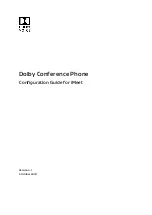
D14330.09 TANDBERG E20 ADMINISTRATOR GUIDE (TE2.1) February 2010
16
What’s in this Guide?
Introduction
Deploying E20
Using E20
The Settings
Advanced settings
Deploying E20
HTTP Bootstrapping
There are situations where service providers prefer that users need not enter
any information at all. Instead, they want the E20 to retrieve all the information
necessary by itself—through pro-active behavior using HTTP or HTTPS.
The E20 will then typically contact a web service to get the information it
needs to configure itself. This web service could include large databases
enabling the E20s to do lookups based on specific device identifiers to retrieve
provisioning information for specific E20 devices. The E20s will identify
themselves to the web server using unique device identifiers such as serial
number and Ethernet MAC address.
Since these identifiers are unique, they will enable the web server to convey
targeted provisioning details to the specific E20 requesting the information.
For convenience, the system administrator or service provider may override a
future global web service by setting up their own web service, if necessary.
This is possible through the use of different DNS names for the local and
global web services. Overriding the global web service is possible for
enterprises and service providers in control of their own DNS domain.
If you have no control of your own DNS domain, overriding the global web
service will involve another party and therefore easily end up being more
difficult.
Contact your local TANDBERG representative for more on this.
HTTP POST
<xml> redirect </xml>
Web server
E20
HTTP POST
<config> … </config>
Web server
E20
HTTP POST
<SW> … </SW>
Web server
E20
















































